Is a Class 1 Vapor Retarder Good Enough for Crawl Space Encapsulation?
For starters, is it Class I or Class 1? Fun fact: it’s actually Class I.
I get asked by both homeowners and contractors alike what a Class I vapor retarder is. If you’ve been researching a DIY crawl space encapsulation project, it is possible you’ve stumbled across this reference as well. In this blog post, I’ll answer what a Class I vapor retarder is, but I’m also going to use this space to explain why a Class I vapor retarder, although referenced in code as a threshold, may not be satisfactory for your project. To get you started on the right foot, we’ve made it easy for you to look up the current version of code governing your jurisdiction.
What Do the Crawl Space Building Codes Say?
It is possible you’ve seen Class I vapor retarders referenced in the 2015 International Residential Code (IRC) in Section R408 Under-Floor Space (it is referenced in the 2012 IRC as well). Here’s the specific language from the 2015 IRC referencing a Class I Vapor Retarder:
R408.3.1 Unvented crawl space
Ventilation openings in under-floor spaces specified in Sections R408.1 and R408.2 shall not be required where the following items are provided:
- Exposed earth is covered with a continuous Class I vapor retarder. Joints of the vapor retarder shall overlap by 6 inches (152 mm) and shall be sealed or taped. The edges of the vapor retarders shall extend not less than 6 inches (152 mm) up the stem wall and shall be attached and sealed to the stem wall or insulation.
Essentially, this section of code is saying that if you cover the walls and ground of your crawl space with a Class I vapor retarder (known as encapsulating) you can remove or close off your ventilation to the exterior. For more information on the pros and cons of ventilation, you can read my blog article about eliminating crawl space vents.
Okay, so what is a Class I vapor retarder?
A Class I vapor retarder is a material with a permeance less than 0.1. That definition may be difficult to understand without some additional context. Permeance, for example, is the amount of moisture vapor that can pass from one side of an object (in this case a plastic liner/sheet) to the other.
So, is 0.1 perms a lot of moisture passing from one side of the liner to the other or is it a little? Well on average, in sustained conditions of 73.4 degrees Fahrenheit and a relative humidity of 50 ± 2% (which are the requirements of ASTM E1745) a 1,300 sq. ft. crawl space, with a liner of 0.1 perms allows over 4 gallons of moisture vapor to pass through in a year. That amount of moisture will contribute to elevated humidity levels (which could impact your home’s energy efficiency) in your crawl space and could lead to indoor air quality issues.
Crawl Space Vapor Barrier Options
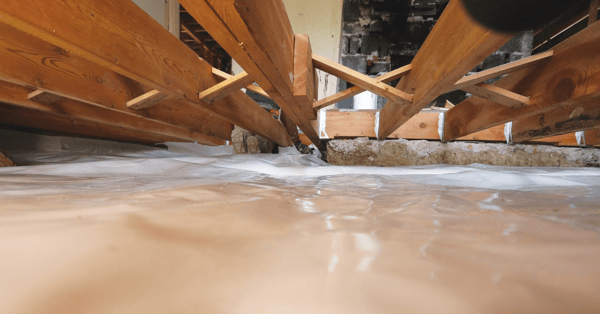
Now you are probably wondering, “what additional options do I have if a Class I vapor retarder still contributes to a considerable amount of moisture within the home?” A lower permeance option would be a material the industry classifies as a vapor barrier. The American Concrete Institute (ACI) and other established organizations draw a distinction between vapor retarders and vapor barriers on a basis of their permeance threshold.
- A vapor retarder defined by ASTM E1745 is a material with a permeance ranging betweem 0.01 and 0.10 perms.
- A below-slab vapor barrier is often defined as a material having a permeance rating below 0.01 perms.
A home has six sides; a top, a bottom, and 4 vertical walls. Each of those sides has differing moisture considerations (which is why you will see different permeance values for different construction materials in the chart below). One thing you can be sure of, is that no amount of moisture coming in from the bottom of the home (from the soil) is ideal and the more that comes in, the more the rest of your mechanical systems and other building materials must contend with.
Let’s examine the different class levels and common types of building materials you might be familiar with:
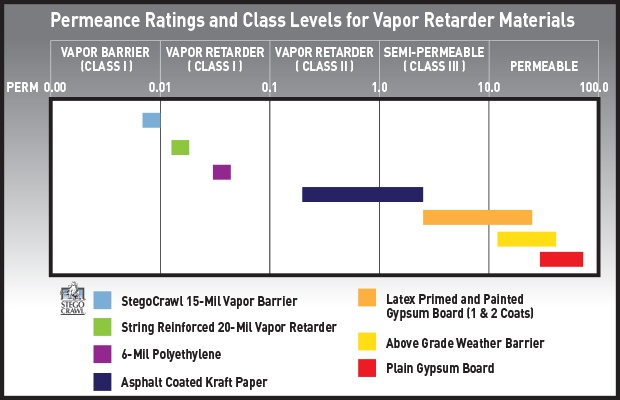 Various data points within this chart are provided by Stan Gatland, Manager of Building Science Technology: https://www.certainteed.com/insulation/vapor-retarders-and-moisture-management/
Various data points within this chart are provided by Stan Gatland, Manager of Building Science Technology: https://www.certainteed.com/insulation/vapor-retarders-and-moisture-management/
How low should your vapor barrier permeance be for your crawl space?
Like all materials you put in your home, there’s usually a trade-off between function and price. For crawl space liners, you typically see products in 3-4 echelons. There are liners with an aluminum component, there are liners with string used for “reinforcement”, there are homogenous, highly engineered films (like Stego), and then there’s poly. Each of those categories typically has a different price point and your desired outcome should be a factor in your decision.
Here’s how I think about these things. For starters, although all those categories are technically Class I vapor retarders, realistically, when most people think of a Class I vapor retarder they’re thinking of 6-mil poly. In addition to allowing a significant amount of moisture to pass through, 6-mil poly is subject to puncture and tears during installation, and considerable deterioration over time (due largely to the fact that the resins used to make poly are recycled). Code is often written as a minimum threshold to be met in order to preserve a level of safety for homeowners. Depending on your situation, meeting that threshold may be your number one priority. However, if you plan to do the work just this one time and you are in a position to capitalize on other benefits of encapsulating a crawl space, it would be worth your while to exceed code’s minimum threshold. If you’re anything like me, you won’t settle for compromise. I’d only want to do this once, I’d want to do it right, but I’d want it to be affordable.
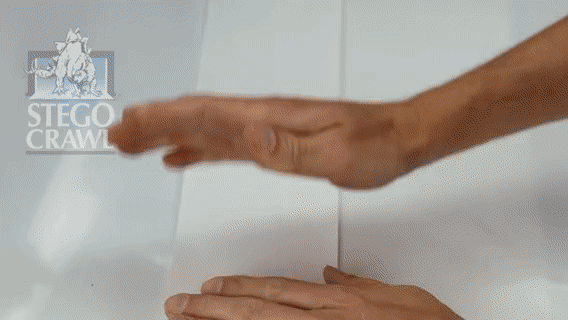
Getting ready to install your crawl space liner? Check out our video that provides a step-by-step guide on how to install your crawl space vapor barrier.
Properly encapsulating a crawl space with a low permeance, durable vapor barrier has a lot of benefits
- Reducing latent loads, for example, helps your HVAC system run more efficiently by reducing the amount of moisture-laden air your HVAC system must contend with.
- Cutting down on the humidity in your home can also assist with better indoor air quality (IAQ) by reducing the occurrence of mold and mildew.
- A vapor barrier used in conjunction with a radon system can also reduce other contaminants that would otherwise be entering your home unchecked.
A 15-mil liner with a permeance below 0.01 can accomplish all of the above without breaking the bank.
If you’re ever in need of assistance picking the right vapor barrier material for your project, please don’t hesitate to reach out to me or Stego Industries. We will connect you with your local Stego representative in order to get you pointed in the right direction.

Written by Tom Marks
Tom Marks is the Business Development Project Manager with Stego Industries, LLC. He has been with Stego since 2007, serving many years as the Rocky Mountains Regional Manager. Now, his focus is geared toward vapor barrier solutions for new and existing homes as the Product Manager of the StegoHome and StegoCrawl brands. In addition, Tom serves as Sustainability Manager, overseeing Stego’s leadership in holistic product and corporate sustainability. Tom enjoys working with a wide range of project team members and customers to incorporate effective sub-slab vapor protection and create healthy, sustainable homes and buildings.
- Stego (26)
- StegoCrawl (24)
- Stego-Awareness (17)
- StegoHome (15)
- Case Studies (14)
- StegoCrawl-Consideration (12)
- StegoCrawl-Awareness (11)
- Customer Stories (9)
- Stego-Consideration (9)
- Pango (8)
- StegoHome-Consideration (8)
- Beast (7)
- How to Install (7)
- StegoHome-Awareness (7)
- Drago (5)
- Pango-Awareness (5)
- Beast-Awareness (4)
- Beast-Consideration (3)
- Drago-Awareness (3)
- Pango-Consideration (3)
- Stego IQ (3)
- Drago-Consideration (2)
- StegoCrawl-Decision (2)
Popular Posts
Stay Connected.
Enter your email below.




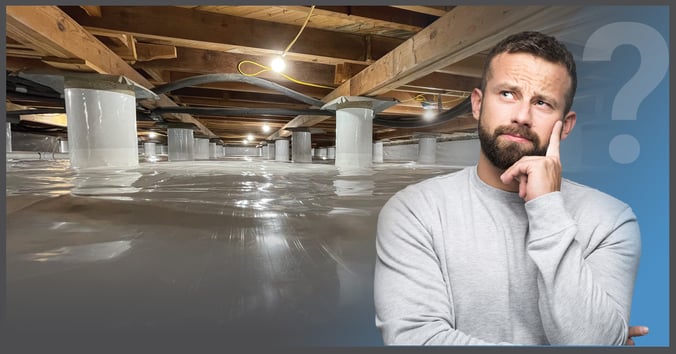

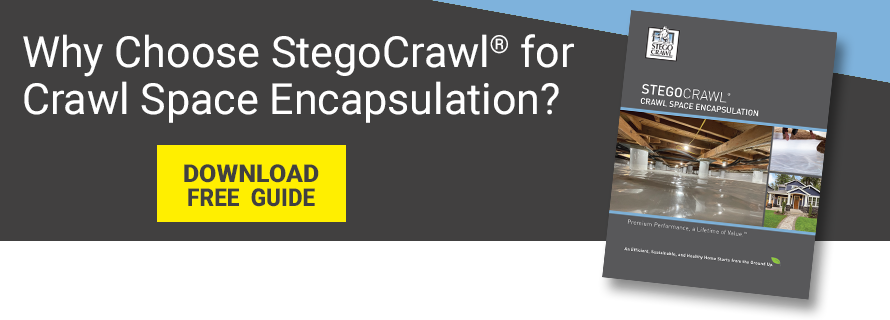


Post Comments